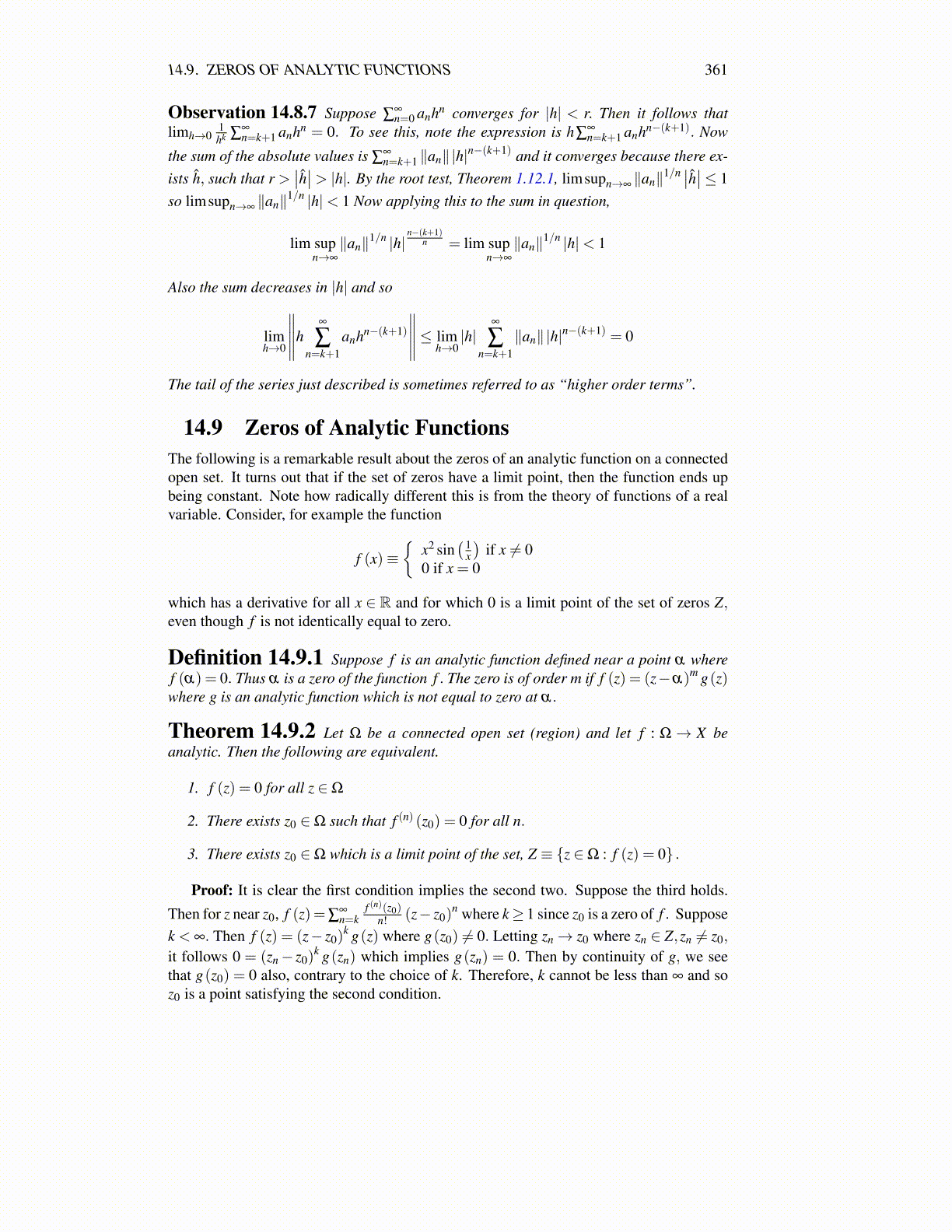
14.9. ZEROS OF ANALYTIC FUNCTIONS 361
Observation 14.8.7 Suppose ∑∞n=0 anhn converges for |h| < r. Then it follows that
limh→01hk ∑
∞n=k+1 anhn = 0. To see this, note the expression is h∑
∞n=k+1 anhn−(k+1). Now
the sum of the absolute values is ∑∞n=k+1 ∥an∥|h|n−(k+1) and it converges because there ex-
ists ĥ, such that r >∣∣ĥ∣∣> |h|. By the root test, Theorem 1.12.1, limsupn→∞ ∥an∥1/n ∣∣ĥ∣∣≤ 1
so limsupn→∞ ∥an∥1/n |h|< 1 Now applying this to the sum in question,
lim supn→∞
∥an∥1/n |h|n−(k+1)
n = lim supn→∞
∥an∥1/n |h|< 1
Also the sum decreases in |h| and so
limh→0
∥∥∥∥∥h∞
∑n=k+1
anhn−(k+1)
∥∥∥∥∥≤ limh→0|h|
∞
∑n=k+1
∥an∥|h|n−(k+1) = 0
The tail of the series just described is sometimes referred to as “higher order terms”.
14.9 Zeros of Analytic FunctionsThe following is a remarkable result about the zeros of an analytic function on a connectedopen set. It turns out that if the set of zeros have a limit point, then the function ends upbeing constant. Note how radically different this is from the theory of functions of a realvariable. Consider, for example the function
f (x)≡{
x2 sin( 1
x
)if x ̸= 0
0 if x = 0
which has a derivative for all x ∈ R and for which 0 is a limit point of the set of zeros Z,even though f is not identically equal to zero.
Definition 14.9.1 Suppose f is an analytic function defined near a point α wheref (α) = 0. Thus α is a zero of the function f . The zero is of order m if f (z) = (z−α)m g(z)where g is an analytic function which is not equal to zero at α.
Theorem 14.9.2 Let Ω be a connected open set (region) and let f : Ω → X beanalytic. Then the following are equivalent.
1. f (z) = 0 for all z ∈Ω
2. There exists z0 ∈Ω such that f (n) (z0) = 0 for all n.
3. There exists z0 ∈Ω which is a limit point of the set, Z ≡ {z ∈Ω : f (z) = 0} .
Proof: It is clear the first condition implies the second two. Suppose the third holds.
Then for z near z0, f (z)=∑∞n=k
f (n)(z0)n! (z− z0)
n where k≥ 1 since z0 is a zero of f . Supposek < ∞. Then f (z) = (z− z0)
k g(z) where g(z0) ̸= 0. Letting zn→ z0 where zn ∈ Z,zn ̸= z0,
it follows 0 = (zn− z0)k g(zn) which implies g(zn) = 0. Then by continuity of g, we see
that g(z0) = 0 also, contrary to the choice of k. Therefore, k cannot be less than ∞ and soz0 is a point satisfying the second condition.